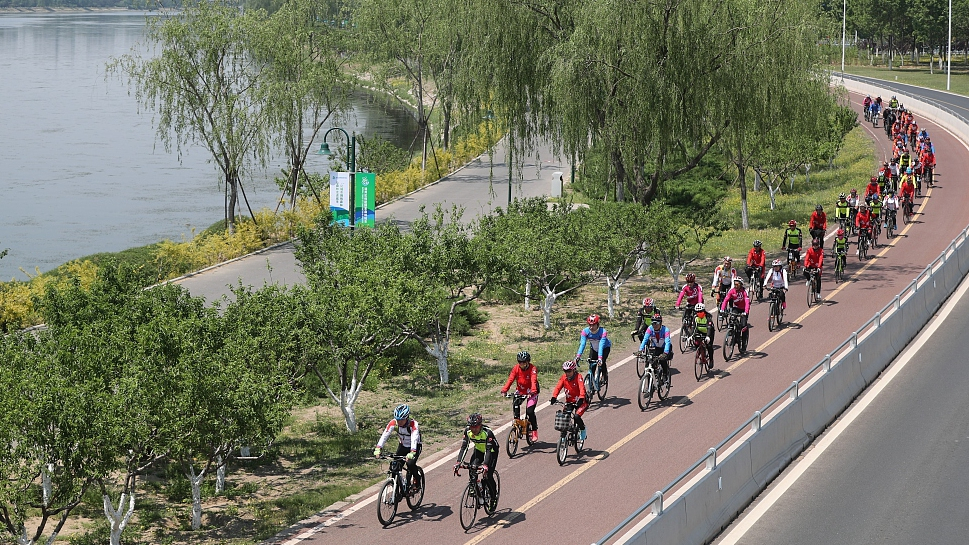
Cyclists ride in urban Beijing. /VCG
Cyclists ride in urban Beijing. /VCG
Editor's note: Alexander Ayertey Odonkor is an economic consultant, chartered financial analyst, and chartered economist with an in-depth understanding of the economic landscape of countries in Asia and Africa. The article reflects the author's opinions and not necessarily the views of CGTN.
Cycling is an indispensable component of any development strategy designed to foster sustainable development. In a nutshell, cycling is economically, environmentally and socially sustainable; all these elements are vital for achieving sustainable development. Considered to be a low-impact aerobic exercise, cycling improves mental and physical health; enhances mobility, occupies little space and is less destructive to the environment as compared to vehicles and other forms of transportation.
In spite of the many benefits of cycling, this sustainable form of transportation, which is suitable for short and medium-distance trips, has been underutilized in many parts of the world. This has contributed substantially to high carbon emissions from vehicles, specifically sport-utility vehicles (SUVs), which are the most patronized around the world.
Excerpts from the World Energy Outlook 2020, a flagship publication of the International Energy Agency (IEA), show that even though global energy-related carbon emissions declined by 7 percent in 2020 as a result of COVID-19, which is the largest drop in history, carbon emissions from SUVs soared. Although lockdowns and other COVID-19 protocols have limited the use of cars, SUVs, which are comparatively larger and less fuel-efficient than other cars, have consumed more oil than any other car during this duration. In 2020, oil consumption for SUVs surpassed what was recorded in 2019 as these vehicles consumed 5.5 million barrels per day. While carbon emissions across all sectors declined in 2020, SUVs recorded an increase of 0.5 percent in carbon emissions.
Over the last decade, global carbon emissions from SUVs have increased exceedingly. During this 10-year period, SUVs have remained the major driver of energy-related emissions in developed countries, contributing 300 million tons of CO2 (Mt CO2). Currently, total carbon emissions from SUVs is comparable to that of the entire maritime industry, which includes international shipping. The upswing in carbon emissions from SUVs is attributed to the growing preference for these vehicles which are considered to be symbols of affluence.
Recent data shows that in 2020, SUVs accounted for a record 42 percent of all cars that were sold in the global car market, 3 percentage points higher than 2019. Carbon emissions from SUVs continue to surge as the global fleet of these vehicles increase. According to the World Energy Outlook 2019, SUVs have been the second-largest contributor to the increase in the world's CO2 emissions since 2010; the largest contributor is the power sector.

Cyclists ride in green lanes in Tongzhou District, Beijing. /VCG
Cyclists ride in green lanes in Tongzhou District, Beijing. /VCG
To mitigate carbon emissions from SUVs, the world will have to adopt sustainable forms of transportation that align with the climate goals of the Paris Agreement and also bolster sustainable development. Apart from promoting the use of electric vehicles to mollify carbon emissions, cycling is also an important means of transportation that facilitates mobility and supports sustainable development. According to the United Nations, cycling can improve efforts to achieve the sustainable development goals (SDGs). For example, to achieve sustainable cities and communities, which is one of the SDGs, cycling can play an essential role in making human settlements more inclusive, resilient, safe and sustainable. The advantage cycling has over other forms of transport in accomplishing this sustainable development goal is that it is cheaper, non-polluting, and promotes mental and physical health.
In fact, cycling enhances the energy efficiency of the transport system as it relies on renewable human power to convey people, goods and services to their desired destination in the most efficient mode. This affordable means of transport has proven to be efficacious in the fight against rural poverty. Through cycling as a means of transport, farmers in rural and remote communities are able to transfer their harvest from their farms to local markets at a reduced cost; this limits post-harvest losses and improves food security.
In least developed countries (LDC), where good road networks are limited or non-existent in some cases, cycling has been a reliable form of transport for accessing educational facilities, job opportunities, markets and even health facilities. In these rural areas, community health workers use bicycles to deliver quality outreach services to people in distant communities. With the help of the bicycle, medications and life-saving information is transported to remote communities, which promotes the well-being of people living in these places.
To augment the efforts of major exporters of bicycles such as China, Germany and Netherlands in their quest to promote mobility, protect the environment and support healthy living in a sustainable way, it is imperative for countries around the globe to align a cycling-inclusive approach with their sustainable development strategies.
This will ensure that adequate resources, such as road infrastructure, which makes suitable provision for cycling, are developed to encourage a large share of the global population adopts cycling for their short and medium-distance trips. If this is achieved, it could increase mobility and mitigate carbon emissions, which will stimulate healthy living and sustainable development.
(If you want to contribute and have specific expertise, please contact us at opinions@cgtn.com.)

